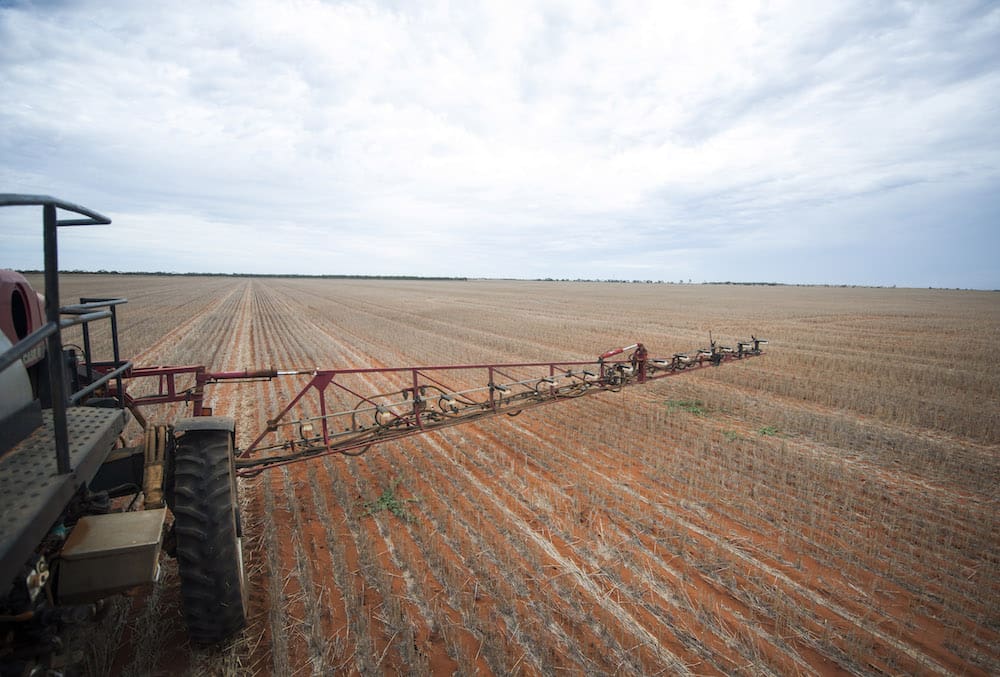
A Weedit precision sprayer in action on Craig Thompson’s Yuna WA property
Grain growers in Queensland and New South Wales are being encouraged to consider the potential impact of residual herbicides as they weigh up their summer crop planting options.
Experts warn predominantly dry conditions across much of eastern Australia’s grain belt through winter may have prolonged the efficacy of residual herbicides applied in paddocks earlier in the season.
Grains Research and Development Corporation (GRDC) Crop Protection Officer North Vicki Green said the simple fact was herbicides generally needed moisture to breakdown.
“The dry conditions during winter may mean herbicides are present in the soil in greater concentrations than growers would usually expect going into summer planting,” she said.
“This is not a dire situation, rather it just means growers and their advisers may have to look more closely at crop choice and variety selection ahead of planting.
“Most growers will be aware of the potential risks of residual herbicides in a season like this, but GRDC does have up-to-date information available if people want guidelines to soil behaviour with regard to pre-emergent herbicides.”
Mrs Green said when it did rain growers could also use the emergence of specific weeds as an indicator of what herbicides were still active in the soil.
“Unfortunately, when it rains weeds are usually the first things to respond – the upside is growers can use what weed types emerge as an indication of what residual herbicides are still in the soil,” Mrs Green said.
The GRDC is committed to building grower and adviser knowledge about weed management and more specifically herbicides and their performance in different soil types under different seasonal conditions.
In recent years the GRDC has run a series of workshops, aimed at enhancing industry knowledge of herbicides. The workshops were co-ordinated by Independent Consultants Australia Network’s (ICAN) specialist Mark Congreve, who has also developed technical manuals to explain the science that underpins herbicides.
“Greater knowledge of how herbicides work enables grain advisers to better optimise their advice to growers on herbicide use,” he said.
“Manuals and training through these workshops covered both the soil behaviour of pre-emergent herbicides and the modes of action of post-emergent grass herbicides.
“In the pre-emergent workshop this included volatility, photodegradation, influence of organic matter, soil binding coefficients and cation exchange capacity of the soil. Also covered were water solubility, breakdown pathways and DT50 values and how these product features coalesce to inform how different herbicides behave in the soil.
“For the post-emergent herbicides, we covered how different modes of action work, herbicide entry through the leaf, translocation and metabolism. The complexities of herbicide resistance and the implications these factors have in optimising performance of particular modes of action were included.”
Mr Congreve said more than 1000 advisers and growers attended nearly 60 workshops held across Queensland and NSW.
“The feedback from the workshops was very positive and supports the GRDC’s decision to invest in industry training,” he said.
“The broadacre agronomists who attended reported that the material presented was informative, easy to understand, had practical application and was complemented by the comprehensive technical materials that were part of the package.
“Importantly, the material proved to be beneficial to both highly experienced and graduate agronomists.”
Mrs Green said the take home message from the series of workshops was both growers and agronomists appreciated opportunities to learn and build on their knowledge in areas that had practical application in their day-to-day work.
“We were impressed by the feedback from workshop attendees and it has been the catalyst for ongoing GRDC investment in this area,” she said.
“The GRDC is committed to building industry capacity and that means investing in agronomists and growers so they have the skills and knowledge needed to guide on-farm management decisions that influence profitability.”
Mrs Green said the value advisers put on the technical manuals, developed as part of the workshop series, has also prompted the GRDC to make online versions available to all interested stakeholders.
“When advisers and agronomists tell us something is valuable and worth having we listen, hence our decision to make technical copies of the manual available beyond workshop attendees.”
The GRDC Soil behaviour of pre-emergent herbicides in Australian farming systems: a reference manual for agronomic advisers is available at bit.ly/2LDP5I2 or hattps://grdc.com.au/resources- and-publications/all- publications/publications/ 2015/08/ soilbehaviourpreemergentherbic ides.

HAVE YOUR SAY